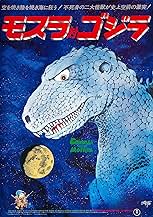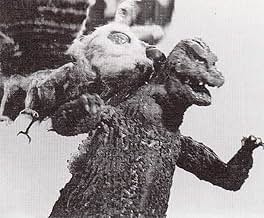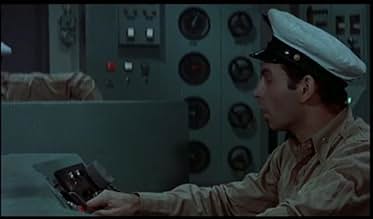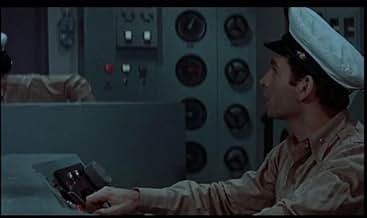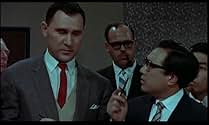Ein Taifun schwemmt ein Ei an Land. Es wird von Unternehmern beansprucht, die sich weigern, es seinem rechtmäßigen Besitzer zurückzugeben. Bald erhebt sich Godzilla in der Nähe von Nagoya, d... Alles lesenEin Taifun schwemmt ein Ei an Land. Es wird von Unternehmern beansprucht, die sich weigern, es seinem rechtmäßigen Besitzer zurückzugeben. Bald erhebt sich Godzilla in der Nähe von Nagoya, der vom gleichen Taifun an Land gespült wird.Ein Taifun schwemmt ein Ei an Land. Es wird von Unternehmern beansprucht, die sich weigern, es seinem rechtmäßigen Besitzer zurückzugeben. Bald erhebt sich Godzilla in der Nähe von Nagoya, der vom gleichen Taifun an Land gespült wird.
- Auszeichnungen
- 1 Nominierung insgesamt
Empfohlene Bewertungen
The plot is strong and,within the demands of a Japanese monster movie,logical. The human characters are mostly reasonably interesting and we don't mind spending time with them for the first half hour or so until the monsters show up. The effects are excellent considering the budget-the constant criticism of the effects in these films is sometimes valid but certainly not here. The two monster battle scenes are shorter then usual but exciting and amusing without being completely comical. Godzilla is at his most fearsome in this film,and he even threatens children,while the graceful,mystical Mothra is a great adversary. Akira Ifikube's music is thrilling {if repetitive}and there are even important issues such as the destruction of the environment and the evils of big business put into the film without spoiling the fun.
Some other Godzilla films may be more funnier,or more exciting,or more spectacular,or whatever,but Godzilla Vs Mothra may well be the artistic peak of the series,with all the elements woven into an immensely satisfying whole,and,unusually for a Japanese sci-fi movie of the time,it was not altered much for it's US version,with only some minor cuts,not-too-bad dubbing and,best of all, the addition of a scene featuring Godzilla!
This movie is directed by Ishirô Honda (Godzilla, 1954) and stars Akira Takarada (Godzilla, 1954), Yuriko Hoshi (Ghidorah, the Three-Headed Monster), Hiroshi Koizumi (Mothra) and Kenji Sahara (Godzilla, 1954).
I loved the story setup and the giant Easter egg that eventually becomes Mothra. I'll always enjoy the concept of the little ladies being the spokesman for the tribe and Mothra. Godzilla's emergence was great but his facial expressions in the film had me cracking up. The final battle is entertaining and also pretty funny.
Overall this is a film that's more fun than good but an absolutely must see for fans of the Godzilla franchise. Mothra is a unique and fun characters. It's easy to see why she became a mainstay within the franchise. I'd score this a 6.5/10 and strongly recommend seeing it.
Godzilla's appearance in this movie is very good, however, there are some problems with his mouth in this movie. They are very wobbly and that's because in the sequence where Godzilla emerges from underground, the suit got damaged and the mouth got loose. And later on, the head caught on fire, although if you ask me, that was pretty cool and showed how invincible and invulnerable Godzilla really is.
The music's superior with legendary composer Akira Ifukube campusing the score. Eiji Tsuburaya handles the great special effects and Ishiro Honda's talents as a director come through in this movie.
Wusstest du schon
- WissenswertesWhen the protagonists arrive on Infant Island, the skeleton of a turtle is seen in the background where it appears move slightly. This is often misunderstood to be an error but it's actually an intentional choice, inspired by the Italian documentary Mondo cane (1962), which showcased the decomposed remains of a turtle that swayed in the wind. Many fans however took it further, pointing out that it appeared to blink suggesting it was indeed a living, albeit disfigured, creature. The creature eventually was nicknamed "Skeleturtle" and developed a cult following. It would make a cameo in a Godzilla comic and Toho themselves would sell merchandise of the creature, cementing its status as an actual kaiju with it's official name being translated to "Mystery Bones of Infant Island".
- PatzerWhen the Mothra larva grabs onto Godzilla's tail and Godzilla flings it around, the skin of the Mothra larva cracks. This is because it is being damaged by Godzilla.
- Zitate
[the natives of Infant Island must decide if they are willing to answer Japan's pleas for help]
Professor Miura: It's a selfish request, but can you help us?
Shobijin (Twin Fairy), Shobijin (Twin Fairy): We must refuse. We have no faith in your world.
Professor Miura: Including us?
Shobijin (Twin Fairy), Shobijin (Twin Fairy): We're very sorry.
Ichiro Sakai: What do we do now?
Professor Miura: It's clear we're not welcome here.
Junko Nakanishi: Please listen to me. I understand why you don't trust us, but even as we speak, many are dying because of Godzilla. Many of them are good people, but even bad people have a right to live. You may call it divine retribution, but all people are equal before God. God plays no favorites. Please, we need your help.
Ichiro Sakai: We too want a world where we can trust one another. But the more people there are, the more difficult it becomes. Nevertheless, we'll never give up. We're working hard to make the world a better place. Please, don't be quick to judge us.
- Alternative VersionenThe "Frontier Missile" sequence is the only example of kaiju footage contained in foreign release prints but not in the original cut. This footage slightly alters the arrangement of events of the American and European versions. This footage was filmed at AIP's request and originally excluded from the Japanese cut to keep out the very patriotic American iconage of the scene. It is now featured as bonus material on the Japanese laserdisc.
- VerbindungenEdited from Weltraumbestien (1957)
Top-Auswahl
Details
Box Office
- Weltweiter Bruttoertrag
- 492 $
- Laufzeit1 Stunde 27 Minuten
- Sound-Mix
- Seitenverhältnis
- 2.55 : 1
Zu dieser Seite beitragen








